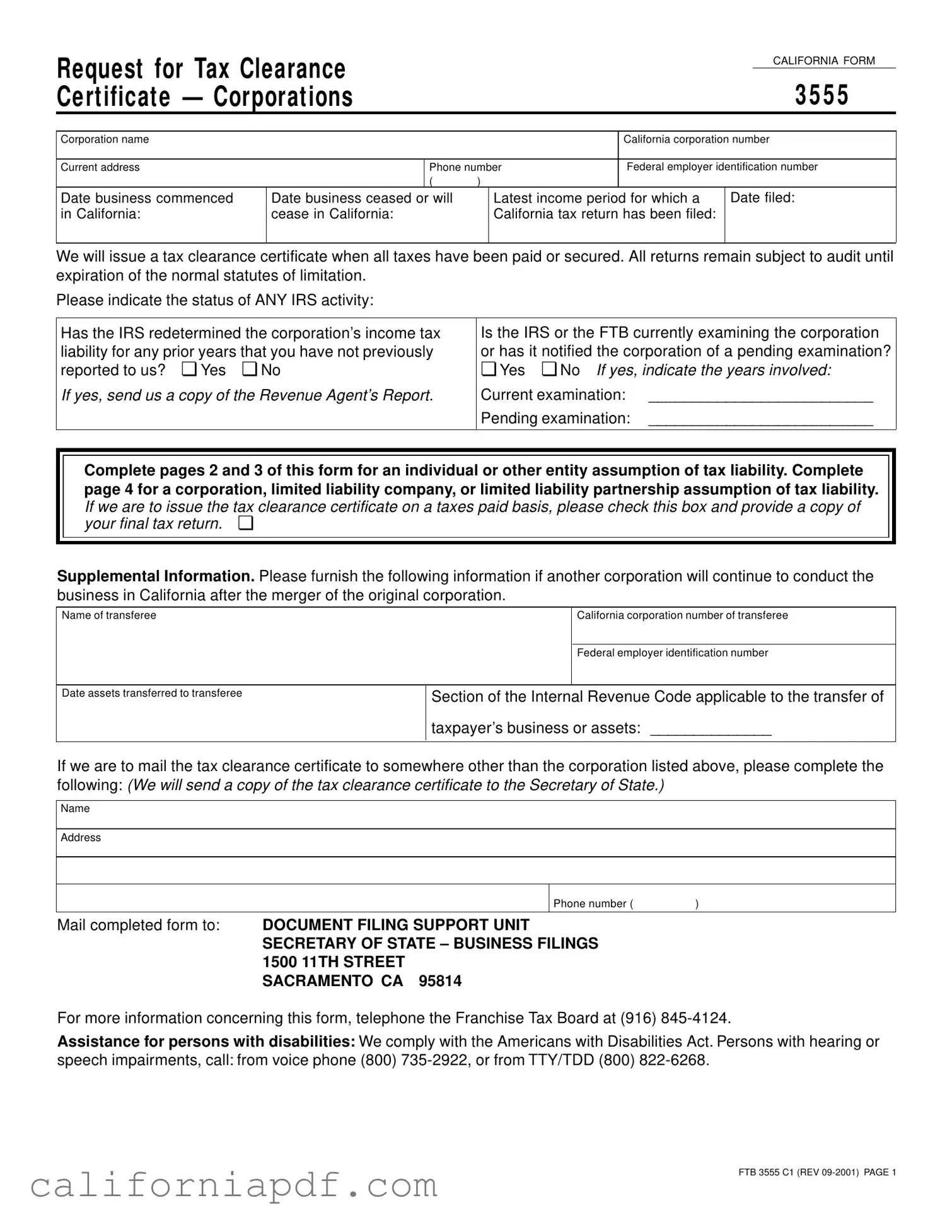The Form 3555 for Request for Tax Clearance from California resembles the IRS Form 4506, Request for Copy of Tax Return, in several foundational ways. Both forms are integral to verifying past tax compliance and ensuring that all necessary taxes have been paid or accounted for before proceeding with certain financial or legal actions. While the Form 3555 applies specifically to entities in California seeking clearance on state tax obligations, Form 4506 serves a broader purpose, allowing individuals or entities to request copies of their federal tax returns from the IRS. This similarity underscores their common goal of facilitating tax compliance verification.
Another document similar to California Form 3555 is the IRS Form 8822-B, Change of Address or Responsible Party — Business. Form 3555 includes sections for updating current address information for the corporation in question, much like Form 8822-B is used by businesses to notify the IRS of changes in address or responsible party. This overlap shows their mutual emphasis on maintaining current and accurate records to ensure proper communication and tax compliance.
Comparable to Form 3555 is the Statement of Information (Form SI-550) required by the California Secretary of State for most types of corporations. Both documents necessitate detailed information about the corporation, such as addresses, identification numbers, and status updates. The Statement of Information also helps maintain the public record of active corporations, aligning with Form 3555's role in ensuring a corporation's tax obligations are fulfilled as part of the broader regulatory compliance landscape.
The UCC-1 Financing Statement similarly echoes aspects of the Form 3555's functionality, despite serving in a different regulatory spectrum. The UCC-1 is instrumental for creditors to secure interests in a debtor's assets and must include detailed information about both parties. Likewise, Form 3555 ensures that tax liabilities are secured and acknowledged before corporations dissolve or transfer ownership, protecting the state's financial interest.
Form 3555 shares purposes with the Application for Certificate of Revivor (FTB 3557 BC), where businesses in California seek reinstatement after being suspended or forfeited due to tax issues. Both forms are pivotal in resolving outstanding tax matters, although the FTB 3557 BC focuses on restoring good standing status, demonstrating the comprehensive approach to managing tax compliance in California.
Similarly, the Seller’s Permit Application (CDTFA-410-D) aligns with Form 3555 in its requirement for businesses to disclose information upfront for tax compliance. While the Seller’s Permit Application pertains to sales tax collection responsibilities, Form 3555 ensures broader tax liabilities are addressed, highlighting the multifaceted nature of tax regulation and compliance for California businesses.
The Business License Application, required by various local jurisdictions within California, also parallels the Form 3555 in ensuring businesses meet local tax and regulatory obligations. Though more focused on local compliance, this application, like Form 3655, mandates accurate representation of the business's status and intentions, reaffirming the importance of thorough regulatory adherence at both the state and local levels.
Lastly, Form 3555 bears resemblance to the IRS Form 8594, Asset Acquisition Statement under Section 1060. Both require detailed reporting related to business transactions, with Form 3555 focusing on tax clearance during corporational transitions, while Form 8594 is used to categorize and report assets after an acquisition. This similarity underscores the emphasis on transparency and accountability in business changes and tax obligations.




